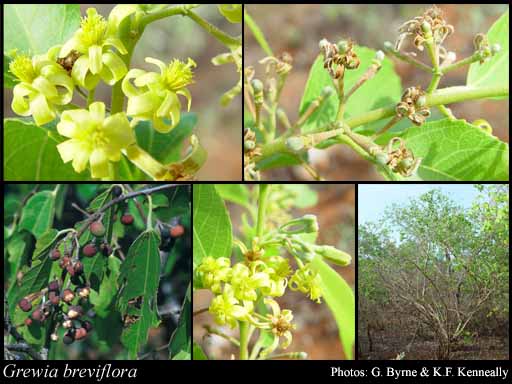- Reference
- Fl.Austral. 1:270-271 (1863)
- Conservation Code
- Not threatened
- Naturalised Status
- Native to Western Australia
- Name Status
- Current
Shrub or tree, 0.4-9 m high. Fl. yellow-orange-green, Nov to Dec or Jan to Feb. Sandy soils, basalt. Often behind coastal dunes or edges of vine thickets.

Scientific Description
Shrub or tree, with glabrous stems. Leaves 45-110 mm long, 20-60 mm wide, not lobed; margins serrate; hairs and scales absent (leaves quite glabrous); stipules present but early deciduous (only visible on youngest leaves). Perianth clearly of two whorls (calyx and corolla), the corolla obvious and prominent. Pedicel present, 3.2-10 mm long; indumentum present, with absent, with stellate hairs present, with gland tipped hairs absent, with scales absent. Epicalyx (extra segments or 'bracteoles' immediately below the calyx) present or absent. Calyx green, 4 mm long, the lobes free, Sessile glands absent, stellate hairs present, scales absent, Terminal appendages absent, number of ribs absent. Corolla yellow, orange or green, 2.7 mm long, glabrous, scales absent. Indumentum (outside) Sessile glands absent. Stamens many, free and inserted at the base of the ovary; filaments present, 1.7 mm long; anthers 0.4 mm long, indumentum absent (anthers glabrous). Staminodes present or absent, appendages absent. Ovary hairs or scales present, simple hairs present, stellate hairs absent; style 1, with a lobed or capitate stigma, 2 mm long, with one style branches or lobes, mostly glabrous, wing absent. Fruits indehiscent and not splitting into sections (drupes), length-width ratio more or less as long as wide, hairs and scales absent, Sessile glands absent; apex rounded; prickles absent (except perhaps a terminal awn); terminal awns or spines present; calyx deciduous before maturity, not accrescent; seeds per loculus 2-4. Flowering time January, November or December. Distribution Botanical Province Northern, IBRA Bioregion North Kimberley, Victoria Bonaparte, Central Kimberley and Dampierland.
Distribution
- IBRA Regions
- Central Kimberley, Dampierland, Northern Kimberley, Victoria Bonaparte.
- IBRA Subregions
- Berkeley, Fitzroy Trough, Hart, Keep, Mitchell, Pindanland.
- IMCRA Regions
- Canning, Kimberley, King Sound.
- Local Government Areas (LGAs)
- Broome, Derby-West Kimberley, Halls Creek, Wyndham-East Kimberley.